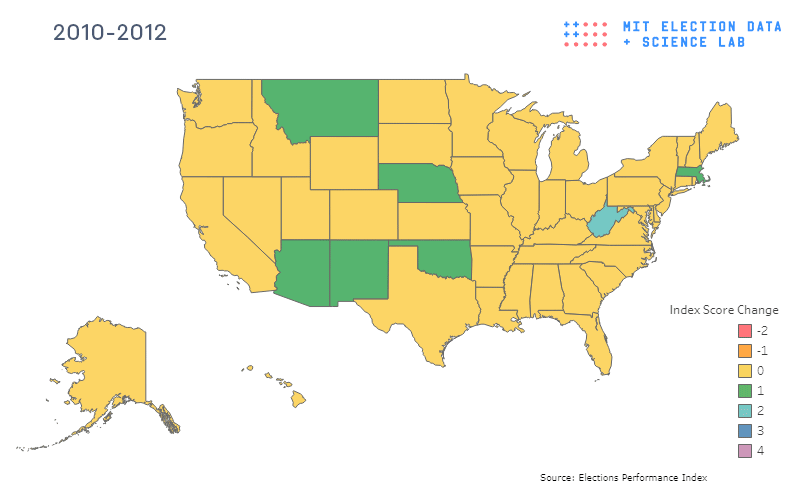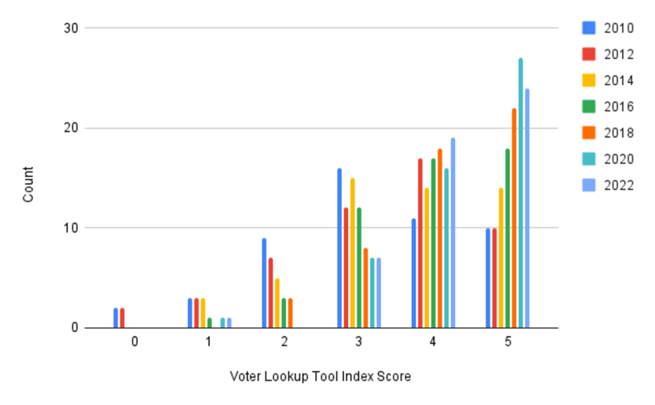Over the years, online lookup tools have become increasingly important for keeping voters informed. The internet became an especially crucial resource in 2020—as procedural changes and public health protocols were quickly implemented to accommodate a global pandemic—and afterward, as a swath of new voting laws were passed across the nation. From checking a polling place’s address to requesting an absentee ballot, online tools have aided Americans in the voting process amidst a changing political landscape.
Since 2010, the Election Performance Index (EPI) has measured the availability of various online voter tools in each state via five indicators, giving states points for each resource that is present. The tools we include in the EPI are:
- Voter registration verification
- Polling place locator
- Absentee ballot status checker
- Provisional ballot status checker
- Precinct level sample ballot
There is also an indicator in the EPI that takes into account whether someone is able to register to vote online, but it’s factored separately from the five basic online voter tools above. We’ll keep discussion of how that indicator looked in 2022 separate from the five tools above, to reflect that.
These criteria were chosen carefully in order to evaluate the accessibility of elections for voters, which is crucial in keeping democracy free and fair. Before diving into this aspect of election performance in 2022, let’s take a quick look at the state of online resources in the previous election.
Lookup Tools in 2020
In 2020, 28 states had all five indicators available online, 15 states had four out of five, 7 states had three out of five, and only one state had just one out of five online resources available. In looking at those numbers, it’s worth noting that some indicators are not applicable for some states, so in these cases they are counted as if they do have that feature (North Dakota, for example, does not require voter registration at all, so there’s no need for the state to provide a way for voters to check their registration.)
At a glance, we see that a plurality of Americans (34.5%) lived in a state where all five tools were available, and over 83% of voters lived in a state with four or five online resources. The high number of digital voting tools likely contributed in some small way to the high voter turnout that year, the highest of any modern election.
However, a significant number of voters were still left without adequate access to online voter resources, an especially unfortunate fact given that voters and election officials alike were struggling to figure out ways to vote safely during the early days of the pandemic, and online sources were some of the only accessible places to obtain information. So we continue to our next question: was there an increase in the tools offered by states in 2022?
Lookup Tools in 2022
Upon analyzing the prevalence of the five tracked online voter tools in 2022, we see that most states (43 out of 51 states, including the District of Columbia) had no changes in their indicator score from 2020. Arizona, Arkansas, and Kansas raised their scores by one point, and Colorado, Connecticut, Maine, New Jersey, and Virginia all lowered their scores by one point.
This is the first year since the EPI was launched that we have not seen an overall increase in the number of online voting tools available to voters.
While the minimal improvements in online resource availability this year may seem disheartening, it is worth noting that there have been massive improvements over the last several election cycles. Until 2022, states were adding more voter lookup tools to their websites every year, with 2016 being the first year a plurality of states had all five. The most dramatic increase in resources occurred between 2014 and 2016, when nearly 30% of states increased one index point or greater.
Additionally, 2022 was not the first year that certain states have backslid in terms of the online voting resources they offer. In fact, three states lost one or more points between 2012 and 2014, as well as between 2016 and 2018. Between 2014 and 2016, four states decreased their online voting resources. Therefore, we can see that the proliferation of online voting resources across the states overall has not been a linear process over time. While it’s true that some states have consistently added more resources between election cycles, others have had more erratic patterns of implementation. This can be seen clearly in the figure below.

There are a handful of states that have kept a consistent score since 2010, including North Dakota, South Dakota, Indiana, Louisiana, and Oregon. Some states have experienced a progression in online voter lookup tools more gradually, eventually plateauing when they reach a top score. An example of this is West Virginia, whose score increased by two between 2010-2012 and then increased by one between 2014-2016, where its score has stayed since. However, a much more common pattern is for a state’s index score to fluctuate up and down over time. New Mexico, for instance, saw its score increase by one between 2010 and 2012, then decrease by two between 2012 and 2014. Its score gradually increased from there, gaining two points between 2014-2016 and an additional point between 2016-2018. Since then, the availability of its online lookup tools have stayed the same.
Online Voter Registration
As previously mentioned, the EPI also measures whether a state allows online voter registration. As with other digital voter tools, online registration makes for a more efficient and accessible experience for voters; states are also able to maintain the same security checks to ensure that everyone registering via an online portal is in fact eligible to vote.
The EPI designates a score of one to states that offer online voter registration, and a score of zero to those that do not. A score of 0.5 is given to states that do not offer online voter registration but do offer voters the ability to update their existing registration information. (This ordinal scoring system is not applicable to North Dakota, as it is the only state with no voter registration at all.)
The availability of online voter registration has remained unchanged since the last version of the EPI was released (however, it is worth noting that Texas’ score in 2020 was then reported incorrectly as having a score of 1, when indeed they have only offered the option to update one’s registration online as of 2016). Some states that do not offer online registration do allow same-day registration, so the importance of this digital resource may not be as crucial for voting access in those places.
Looking at the availability of online voter registration over time, it is clear that the most substantive change occurred between 2014 and 2016, where the number of states offering the tool increased from 21 to 34. There was also a fairly significant increase between 2018 and 2020, where eight additional state websites added online voter registration in those two years. Interestingly, 2022 is the first time we’ve seen a decrease in the number of states with online voter registration available.
While online voter tools can be important indicators of efficient elections, they of course cannot tell the whole story about a state’s electoral performance. Some states may offer more intuitive and helpful resources than others that were given the same index score, and many individual counties offer their own digital tools to assist voters. But if there is one thing that over a decade of EPI data collection has made clear, it is that online voter registration and other lookup tools are worth investing in as we work to improve election administration in the modern era.













